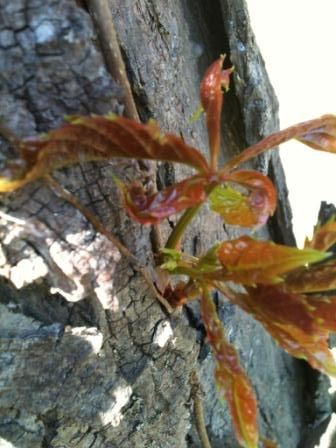
Bluets or Quaker ladies (Houstonia caerulea) are abundant, long-lasting, smile-makers. Enjoy.

Blue cohosh (Caulophyllum thalictroides) has already flowered and is starting to set seeds. The early plant has a soft blue haze to it, still visible a bit in the photo. It is not related to blue cohosh. (Wait until the early winter to dig roots, if at all. This plant is in danger of overharvesting.)

Goldenseal (Hydrastis canadensis) is a rare woodland plant. I planted roots gifted to me by United Plant Savers between the black and blue cohoshes and a lovely patch is forming with little daughter plants springing up.

Fresh Cleavers tincture
Dropperful doses of this tincture relieve PMS, ease tender breasts, and encourage the lymphatic system to work harder, thus relieving edema. Its antispasmodic actions are concentrated in the mucus surfaces of the urinary and digestive systems, make it an ideal ally for those dealing with IC and IBS.
Have a jar, some sharp plant scissors, and 100 proof vodka at hand before you harvest your cleavers.
- Cut the stalks into 1-2 inch pieces and fill a jar totally full with these cut pieces of leaf, flower, stalk, and even seeds.
- Fill jar with vodka. Lid and label.
For the first two weeks, I leave my tincture on a table where I can watch it and add more vodka if necessary. Then I put it away.
Like most tinctures made from fresh plant material, this one will be ready
to use in six weeks.
Weed Walk with Susun

Poison ivy (Rhus toxicodendron, new Rhus radicans) is leaping out of the ground and springing forth from its vines, ready to protect the earth yet again. Leaves in threes are shiny red when they first appear, but soon turn green and blend in with the foliage.

Five-finger ivy, also called Virginia creeper (Parthenocissus quinquefolia) can be mistaken for poison ivy by those who do not count. This is one of the finest of summer's salad greens. All of the leaves, from the babies to the old seniors, taste delicious. Each size has a somewhat different tart flavor.

Red maple (Acer rubrus) seedlings are often mistaken for poison ivy too, but they have but two leaves. Like all tree leaves, maple leaves are astringent and mineral rich.
Wild Seed Condiment
I am especially respectful when harvesting the seeds of annuals. Though annuals do their best to make lots and lots of seeds, they are nonetheless vulnerable to extinction if there are wide swings in weather patterns. I take no more than one-third of what is available from any one plant or patch of plants.
To begin: Taste the leaves of any wild cabbage family plant. If they are tasty or peppery or cabbagy or mustardy, continue. If they taste bitter, find a different plant to harvest. (A few plants in this family have poisonous seeds. Those taste bitter. ) Shepherd's purse seeds are the one mostly commonly used for food purposes. I also enjoy "poor person's pepper" seeds prepared this way.
Then: Harvest a small amount of seeds, just a spoonful, at first. After your first batch, if you like Wild Seed Condiment, you can harvest larger quantities of seeds.
Most likely, you will have to separate the seeds from the inedible husks. Fortunately, there is no chaff, so separation can be done easily by hand.
Toast the seeds in a cast iron frying pan or in a toaster oven until they start to pop.
Crush seeds, using a pestle and a little sea salt, in a mortar.
Put in a shaker top jar and use.

 The Wise Woman Center exists to re-weave the healing cloak of the Ancients. This land is sacred, it is a safe space for women, and a place for the teachings of the Wise Woman way. The Goddess lives here, as do goats, fairies, green witches, and elders.
The Wise Woman Center exists to re-weave the healing cloak of the Ancients. This land is sacred, it is a safe space for women, and a place for the teachings of the Wise Woman way. The Goddess lives here, as do goats, fairies, green witches, and elders.

